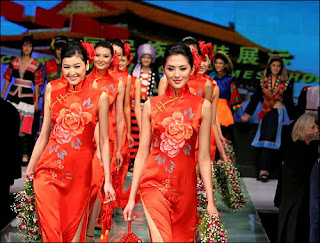The most famous Japanese dress is the kimono world. The kimono (着 物) is the traditional dress, which was the garment of common use until the early years of the war. The Japanese word mono means "thing" and comes from kiru ki, 'carry'.
Kimonos reach the lower parts of the body, neck collars "tita" and wide sleeves. There are several types of kimonos worn by men, women and children. The cut, color, fabric and decorations vary according to sex, age, marital status, time of year and occasion. The kimono dress covering the body in surrounding form and secured with a wide sash called obi.
 The Indian dress is very colorful, varied and elegant. Each state has its regional dress but there are some common styles across the country. Traditionally, women in India often wear saree, is the oldest and most common form of clothing, is 5000 years old, is mentioned in the Vedas - the oldest sacred books of Hindu culture. The saree can be silk or cotton, is 5-6 meters long, is worn with a blouse and long skirt set called petikot, dresses also other styles such as ball gown and the ghaghra rural women -choli and salwar kameez - the gown very common among young urban woman popularly known as punjabi. The Indian wedding dress is usually red or pink but never white. The jewels are usually gold or silver and are very popular and very important in Hindu society, often are the symbol of status of women.
The Indian dress is very colorful, varied and elegant. Each state has its regional dress but there are some common styles across the country. Traditionally, women in India often wear saree, is the oldest and most common form of clothing, is 5000 years old, is mentioned in the Vedas - the oldest sacred books of Hindu culture. The saree can be silk or cotton, is 5-6 meters long, is worn with a blouse and long skirt set called petikot, dresses also other styles such as ball gown and the ghaghra rural women -choli and salwar kameez - the gown very common among young urban woman popularly known as punjabi. The Indian wedding dress is usually red or pink but never white. The jewels are usually gold or silver and are very popular and very important in Hindu society, often are the symbol of status of women. Most traditional men living in India sport a traditional dress called Dhoti. It is worth mentioning that this dress is all one piece rectangular base made of cotton, which has an area of no less than 5 feet long. The Dhoti, is worn by men living in the area of Bengal and the Ganges valley in the north of the country, is usually white or cream.
Most traditional men living in India sport a traditional dress called Dhoti. It is worth mentioning that this dress is all one piece rectangular base made of cotton, which has an area of no less than 5 feet long. The Dhoti, is worn by men living in the area of Bengal and the Ganges valley in the north of the country, is usually white or cream.Traditional African dance is an essential element of Africa’s cultural heritage because it is the living expression of its philosophy, and the living memory of its evolution and cultural wealth over the centuries.
Most people agree there is no such thing as a ‘national Kenya clothing’. First of all, Kenya consists of over 70 ethnic groups (tribes) who all have different traditional dress styles. Secondly, the majority of Kenyans dress more or less Western style. Along the coast – for example in Mombasa or Lamu - where a big part of the population is Muslim, some also dress Arabic style. Kenya - local women in traditional dres.











